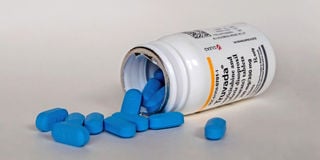Efforts pay off as Kenya ranks high in HIV war

Most countries have not attained the UNAids target of three million users.
What you need to know:
- Kenya and South Africa have led to the region’s growth in the use of Prep.
- The uptake of the drug globally has increased six fold in the past four years.
- Meanwhile, researchers have come up with another HIV Prep prevention drug.
Kenya is the third leading country in the use of HIV-prevention drugs, a study has shown.
The country was recognised for the number of people who have been initiated on pre-exposure prophylaxis (Prep), a drug taken by HIV negative people to prevent the virus.
Coming in after the US, which had the most cumulative Prep initiations at 203,837 and South Africa at more than 100,000 people, Kenya started over 83,000 people on the drug, making it second in Africa.
According to the data presented during the 4th HIV Research for Prevention virtual conference last week, Kenya and South Africa have led to the region’s growth in the use of Prep.
“South Africa recently achieved a huge milestone surpassing 100,000 initiations, Kenya is closely behind at 83,000 as of December 2020 followed closely by Zambia and Uganda,” said Kate Segal, who manages product introduction and access at the HIV prevention advocacy group Avac.
The analysis was done from the Avac Global Prep Tracker to assess trends in global and regional initiation.
The findings revealed that the uptake of the drug globally has increased six fold in the past four years. However, most countries have not attained the UNAids target of three million users.
Prepwatch, a global tracker for the drug’s uptake, found that from the third quarter of 2016 through the fourth quarter of 2020 the uptake increased from 102,446 initiations in 2016 to 928,750 in 2020.
Sex workers
There has been a drop in the number of registered users over the years from 97 per cent in 2018 to 58 per cent in 2019 and last year the figure stood at 55 per cent.
The researchers attributed this to lack of enough knowledge about Prep which has to be taken daily, its cost and even access, which are a challenge.
“We still need to make the drug widely available so that people know it exists. In many countries, the drug is introduced to high-risk populations including gay men and commercial sex workers and this leads to stigmatisation of the product. We need to normalise it and increase the demand,” she said.
The scientists called for improvement on rolling out the drug since it is important in reducing the number of HIV infections.
At the regional level, the drug usage in Sub Saharan Africa substantially expanded from 4,154 initiations in 2016 to 517,727 in 2020, comprising 56 per cent of the global total, according to the researchers. That growth was fuelled by South Africa and Kenya, with 101,007and 82,886 cumulative initiations, respectively, according to the data.
Oceania had also had a high rate of change, with total Prep initiations increasing from 318 to 40,280, an increase largely driven by uptake in Australia. Brazil is leading Prep uptake in Latin America and the Caribbean, accounting for the vast majority of initiations, while Thailand comprises 43 per cent of initiations in Asia.
New drug
In Kenya, the drug, introduced five years ago, was mostly for commercial sex workers and men having sex with men though others are using it, but secretly.
“Countries should ensure apart from placing the drug in health facilities, they are also in strategic places where they can easily be accessed by many, including giving it to community health workers and youth friendly centres. We are working towards a solution to a problem,” she said.
Meanwhile, researchers have come up with another HIV Prep prevention drug. Islatravir, is taken once in a month unlike the everyday pill. A good option for people who dislike taking drugs every day.
People who are reluctant to use daily Prep – 365 pills a year – might rethink their decision if HIV was prevented by taking only 12 pills over a year.
Prof Sharon Hillier of Pittsburgh University, who presented the results during the conference, revealed that based on single-dose phase I studies given to participants, said the drug passed the threshold of efficacy.


